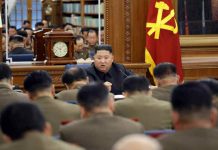The removal of more than 30 cadres in North Pyongan Province represents an anticipated shift in the provincial power structure for the purpose of establishing the Kim Jong Eun leadership structure. Branding existing cadres as corrupt, removing them and transfusing in fresh blood are all part of the liquidation and reformation work of the Kim Jong Eun era.
Although unsurprising in itself, the ‘purge of North Pyongan’ has, however, exceeded expectations in terms of target and scale. Everyone knew that Kim Jong Eun, having guaranteed the loyalty of organs of state security, had begun to work on the Party apparatus, but that he would do so in such a lightning fast and apparently violent manner did come as a surprise.
More than 30 cadres have been dismissed, including the North Pyongan Province propaganda secretary and Guidance Department head. The two, in addition to the head of workers’ unions in the province, were among the ten most powerful Party figures in the whole region. In particular, the head of the Guidance Department could be called the yoke at the core of the egg of provincial Party operations.
But slicing off limbs in this way, only one year after the former North Pyongan Province Party secretary was himself replaced by Lee Man Geon, offers a warning; show absolute loyalty to Kim Jong Eun.
As the second-in-command in practice, Kim has been dealing out cadre changes at higher levels since 2009. This has included inflicting retirement on Kim Young Joo, Kim Il Cheol and more, while rapidly elevating people like Lee Young Ho.
The purging of the former deputy head of the National Security Agency, Ryu Kyung, was taken in much the same way when it came to light earlier this year; namely as a part of the establishment of the succession system.
It was thus to be expected that having changed much of the central structure via the Workers’ Party Delegates’ Conference last year, Kim would begin to realize changes in the provincial structure. Kim is now doing so, exercising his oversight powers via the central Party guidance structure and purging corrupt cadres.
“He can take away from this the ‘effect of a domestic crackdown’, namely the atmosphere of loyalty it creates, and the ‘effect of change’, namely the ability to plant his own younger people by cutting people for being corrupt,” explained Cheong Seong Chang of the Sejong Institute to The Daily NK today.
Such processes are rather common in dictatorships, and this is far from being the first time such events have unfolded in North Korea, either. Various corruption incidents ‘came to light’ during the March of Tribulation in the 1990s, used by Kim Jong Il to quiet complaints about the leadership in Pyongyang.
“Kim Jong Il regularly dismissed people, to both turn people’s anger at the leadership onto the mid-level cadres and at the same time evade responsibility for anything by suggesting that it was mid-level bribery that was precluding the people’s economy from improving,” according to Cheong.
In 1999, for example, there was the simultaneous purging of a number of figures from Yangkang Province, including the provincial Party general secretary and NSA secretary, Unheung County secretary and the political commissar for the No. 376 Unit of the Chosun People’s Army.
The provincial general secretary was dismissed on the premise that he had failed to prevent the rapid influx of ‘capitalist culture’ across the Sino-North Korean border, the NSA man because he had embezzled Party funds, and the Unheung County secretary and political commissar because they had taken bribes. All were subsequently executed, as is also often the case.




















